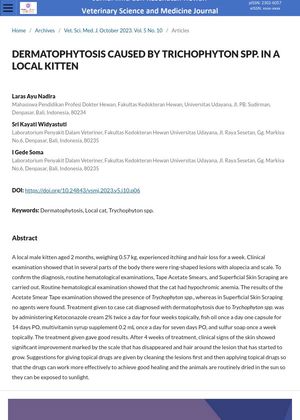TLDR The kitten's skin condition improved significantly after 4 weeks of treatment.
A 2-month-old local male kitten with dermatophytosis caused by Trychophyton spp. was treated with Ketoconazole cream 2% twice daily for 4 weeks, fish oil once daily for 14 days, multivitamin syrup for 7 days, and sulfur soap weekly. The kitten showed significant improvement after 4 weeks, with the disappearance of scales and regrowth of hair around the lesions. The study suggests cleaning lesions before applying topical treatments and exposing the animal to sunlight for better healing.
 2 citations
,
January 2016 in “Skin pharmacology and physiology”
2 citations
,
January 2016 in “Skin pharmacology and physiology” Caragana korshinskii seed oil effectively treats fungal skin infections.
 January 2019 in “Open access journal of mycology & mycological sciences”
January 2019 in “Open access journal of mycology & mycological sciences” The article concludes that proper antifungal treatment is essential for treating scalp fungal infections in children, and trichoscopy is useful for diagnosis and monitoring.
 38 citations
,
July 2010 in “Clinical, cosmetic and investigational dermatology”
38 citations
,
July 2010 in “Clinical, cosmetic and investigational dermatology” To treat tinea capitis in children, oral antifungal medication is necessary, with newer drugs offering shorter treatment times than the traditional griseofulvin.
 55 citations
,
May 2014 in “Journal of feline medicine and surgery”
55 citations
,
May 2014 in “Journal of feline medicine and surgery” Combining systemic and topical treatments, guided by weekly fungal cultures, effectively treats cat ringworm.
 14 citations
,
January 2008 in “Medical mycology”
14 citations
,
January 2008 in “Medical mycology” Canadian porcupines in a Japanese zoo passed a skin fungus to each other.





